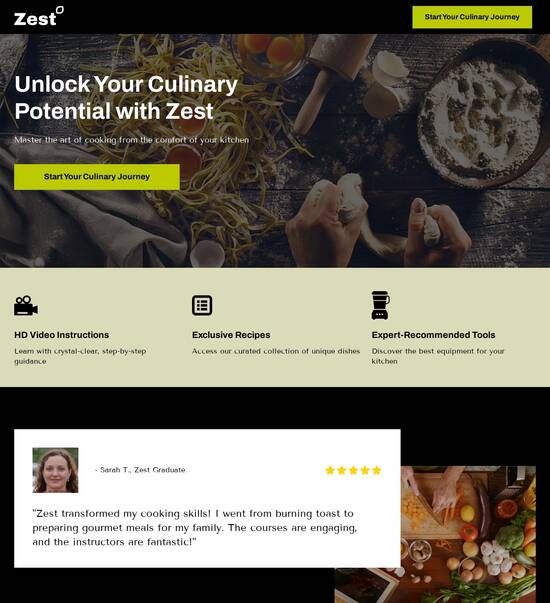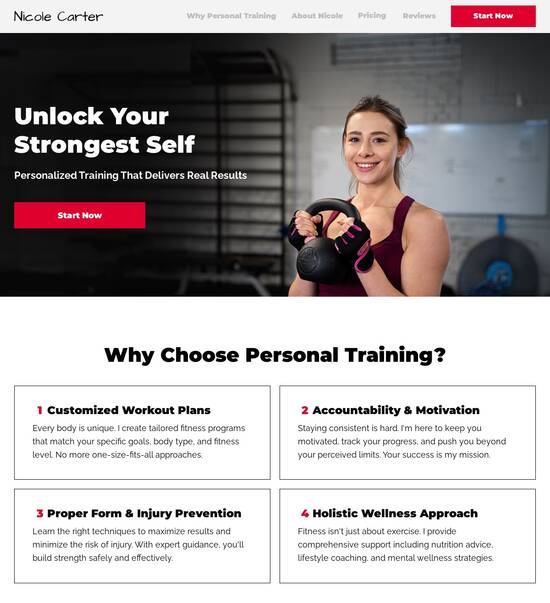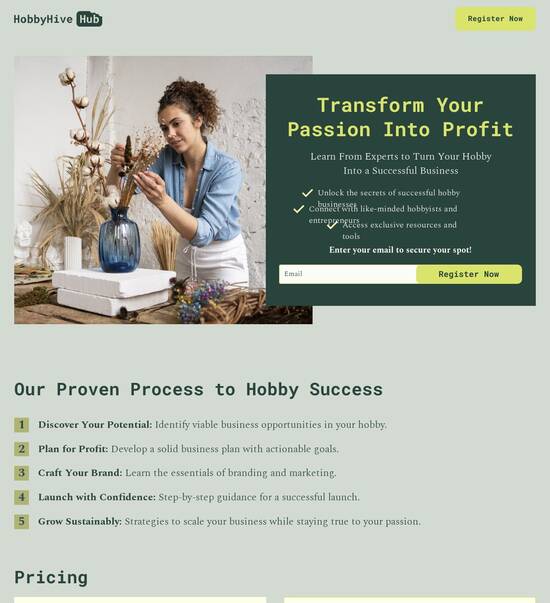
Design DuckDuckGo Browser-ready 403 forbidden page templates
Explore Similar TemplatesAbout template
Choose the best 403 forbidden page template for DuckDuckGo Browser
Recommended templates

Easy to build without coding
With the intuitive drag-and-drop builder, anyone on your team can create high-converting pages without any knowledge of code or design. Make enhancements to your landing page with custom widgets using Javascript, HTML/CSS, or third-party scripts.

Multiple layouts for any industry and goal
Select from 500+ landing page layouts built to boost conversions across industry-specific scenarios. Customize them by adjusting fonts, adding images, and generating on-brand content with the AI assistant. Quickly scale with Instablocks® and Global Blocks that you can save, reuse, and update globally.

Loads fast and looks polished on any device
Every template is responsive, which means they present professionally on any device and load blazingly fast with our Thor Render Engine. You can also power them up with Google AMP technology to deliver an unparalleled mobile experience and drive higher conversions.

Robust analytics & experimentation
Get real-time updates and reporting across all your devices, showing the number of visitors, conversions, cost-per-visitor, and cost-per-lead. Launch AI-powered experiments, run A/B tests, and use heatmaps to analyze user behavior, then optimize your landing page to maximize conversions.







Easy to build without coding
With the intuitive drag-and-drop builder, anyone on your team can create high-converting pages without any knowledge of code or design. Make enhancements to your landing page with custom widgets using Javascript, HTML/CSS, or third-party scripts.
Multiple layouts for any industry and goal
Select from 500+ landing page layouts built to boost conversions across industry-specific scenarios. Customize them by adjusting fonts, adding images, and generating on-brand content with the AI assistant. Quickly scale with Instablocks® and Global Blocks that you can save, reuse, and update globally.
Loads fast and looks polished on any device
Every template is responsive, which means they present professionally on any device and load blazingly fast with our Thor Render Engine.
Robust analytics & experimentation
Get real-time updates and reporting across all your devices, showing the number of visitors, conversions, cost-per-visitor, and cost-per-lead. Launch AI-powered experiments, run A/B tests, and use heatmaps to analyze user behavior, then optimize your landing page to maximize conversions.
All the features you need to build lead-generating landing pages
Explore more featuresLearn how to build top-performing landing pages for any goal
FAQs
Leading the way in building high-performing landing pages





A guide to 403 forbidden page template optimized for DuckDuckGo Browser
When optimizing a 403 forbidden page template for the DuckDuckGo browser, it's critical to understand the unique privacy-focused features it offers. Instapage's powerful landing page platform makes it easy to create a visually appealing and functional template that enhances user experience while prioritizing privacy. This guide will walk you through the essential steps to ensure your 403 error pages not only engage users but also reflect the values aligned with DuckDuckGo's mission.
Understanding the 403 forbidden error
A 403 forbidden error arises when the server understands the request but refuses to authorize it. This can often confuse users who may feel lost when encountering the error. To maintain user engagement, it’s crucial to design a user-friendly 403 forbidden page that provides clear information about why access is denied and guidance on what to do next.
- Clear explanation: Offer a concise description of the error, informing users why they cannot access the requested resource.
- Next steps: Include actionable suggestions, such as returning to the home page or contacting support for assistance.
- Privacy focus: Leverage DuckDuckGo's approach to privacy by ensuring users understand their data won't be tracked during their browsing experience.
Step 1: Design your 403 page with Instapage templates
Begin by selecting a high-converting 403 forbidden page template from Instapage's extensive library. The goal is to create an inviting and functional page without the need for coding skills. Here’s how to proceed:
Step 2: Customize and optimize for visibility
Each template can be easily customized to match your brand’s identity. Optimize your 403 page by focusing on:
- Responsive design: Ensure your 403 page looks great on both desktop and mobile screens.
- SEO elements: Integrate titles and meta descriptions compatible with DuckDuckGo's search algorithms while supporting good SEO practices.
- Accessibility: Confirm that the template adheres to accessibility standards, allowing users with disabilities to navigate your 403 page with ease.
Step 3: Launch and monitor performance
After customizing your template, publish it and monitor its performance. Use A/B testing to assess user engagement and adjust elements as necessary. Regularly check:
- User feedback: Collect data on how users interact with the 403 page and adjust based on their input.
- Analytics tracking: Implement analytics to gauge the bounce rate and success of rerouting users to alternative pages.
- Continuous improvement: Regularly update content and design based on changing user expectations and browser updates.
A well-designed 403 forbidden page can transform an error into an opportunity for engagement. By providing a clear pathway for users despite encountering a roadblock, your site can maintain credibility and trust.
Start optimizing your 403 error pages today with Instapage! Leverage our templates and tools to create a user-centered experience that resonates with DuckDuckGo's privacy-first approach.
People also ask about 403 forbidden page template optimized for DuckDuckGo Browser
403 Forbidden page template optimized for DuckDuckGo browser
Understanding the 403 Forbidden page: Pressing the pause button on unauthorized access
In the digital world, encountering a 403 Forbidden error can be frustrating, yet it serves a crucial purpose. This error code indicates that access to a particular page is forbidden, implying the server understands the request but refuses to authorize it. This often happens due to permissions issues, IP restrictions, or misconfigurations. Understanding this status is paramount for web developers and marketers alike, particularly as user experience should prevail even in error situations. Thus, addressing how we communicate these errors to users, especially those utilizing privacy-focused browsers like DuckDuckGo, is essential.
The anatomy of a 403 Forbidden error
To identify a 403 Forbidden error, it’s useful to understand its distinct features when compared to other HTTP status codes. Unlike a 404 error, which indicates that a page cannot be found, a 403 error suggests that access to the resource is explicitly disallowed. Additionally, while a 500 error denotes server issues, the 403 error isolates itself to user permissions. Common scenarios leading to this error include incorrect folder permissions on the server, blocked IP addresses, and lack of proper authentication credentials.
Misconfigured user permissions blocking public access.
Incomplete .htaccess file causing access denial.
Requesting a forbidden resources such as restricted folders.
The importance of a custom 403 Forbidden page
Having a well-designed custom 403 Forbidden page significantly impacts user experience. It acts as a communication tool to convey access limitations clearly, ensuring users understand why they cannot access requested content. This not only reduces frustration but also enhances the overall credibility of your website. Moreover, it’s an opportunity for brand reinforcement, allowing you to extend your brand’s identity and voice even in tricky situations. A positive user experience can mitigate losses stemming from accessing problems.
Evolution of web browsing: The rise of DuckDuckGo
DuckDuckGo has emerged as a leading search engine, attracting users who prioritize privacy and data security. With users becoming increasingly aware of their digital footprints, DuckDuckGo offers a stark contrast to traditional search engines that often collect and monetize user data. This emphasis on privacy not only impacts how users search but also influences how they interact with websites. A seamless experience is expected, and when confronted with a 403 Forbidden error, the expectations remain—users seek clarity without unnecessary data tracking.
DuckDuckGo ensures users’ search queries remain private.
It doesn't profiles or track users, fostering a sense of security.
Results displayed are uninfluenced by historical data, impacting user expectations.
Crafting the optimal 403 Forbidden page template for DuckDuckGo users
When creating a 403 Forbidden page template designed for DuckDuckGo users, certain features are essential to ensure clarity, brand alignment, and ease of navigation. Clear and concise messaging is paramount; users should be able to understand immediately why they’ve landed on this page. Additionally, incorporating branding elements while maintaining the website’s identity is vital to ensure brand recognition during even the most frustrating user experiences.
Essential features of a 403 Forbidden page template
Effective custom error pages should be equipped with features that foster user engagement and minimize frustration. Some central aspects to consider include:
Clear messaging explaining the error and what it means.
Branding elements, such as logos and color schemes, to reinforce identity.
Interactive components like redirect buttons leading to the homepage or help sections.
Emphasizing user experience in error pages
A focus on user experience must underpin the design of any 403 Forbidden page. Implementing responsive design ensures that users can easily navigate through the page on any device, enhancing accessibility. It’s also essential to prioritize minimalism. Overly cluttered pages can confuse users; instead, they should provide simple paths for redirection to relevant content. Additionally, considering accessibility, such as accommodating users with disabilities, is crucial for maintaining an inclusive digital environment.
Incorporating advanced technologies
To elevate the performance of a 403 Forbidden page, it’s vital to incorporate advanced technologies. For instance, leveraging byte objects can enhance loading speeds, thereby improving user experience. Moreover, integrating error tracking servers can efficiently manage 403 errors, allowing your team to identify trends and rectify frequent issues swiftly. Utilizing modern coding techniques, such as AJAX, can further enhance the interactivity of the error page, making it not just informative but engaging for users.
Enhancing security features in 403 Forbidden pages
The security features behind a 403 error are pivotal. Understanding that a 403 error often arises from server settings designed to protect unauthorized access is critical. To prevent unauthorized access, employing strategies such as checking user credentials can combat many common issues facing users. Furthermore, utilizing secure URLs to maintain integrity strengthens overall site security while also informing the user, indirectly signaling the need for structured access controls.
Tailoring content for DuckDuckGo's unique browsing context
Navigating user intent becomes vital when responding to individuals encountering a 403 error within the DuckDuckGo environment. Users searching on DuckDuckGo may have a different mindset—they seek straightforward answers and clarity. Customizing responses to common queries regarding access restrictions can elevate user satisfaction, while well-structured FAQs can offer quick resolutions. Such tailored content can guide users back to authorized areas, enhancing overall user experience.
Addressing common misconfigurations leading to 403 errors
Identifying and rectifying common misconfigurations that lead to a 403 Forbidden response is essential for web managers. Often, coding errors can emerge from improper settings or typos within URLs that users attempt to access. When discrepancies in server settings are present, these misconfigurations manifest as access restrictions. It’s important to train teams to analyze server response logs effectively and provide insights into how common issues arise and can be mitigated.
Facilitating teams and community engagement
Engaging with users through feedback mechanisms on error pages can provide invaluable insights for improvements. Encouraging user feedback can reveal critical pain points experienced during error encounters. Additionally, facilitating collaboration among teams within an organization to identify frequent access issues can lead to enhanced responses to these errors. Building a community around troubleshooting further bolsters user trust and satisfaction, transforming a negative experience into a constructive dialogue.
Optimizing the 403 Forbidden experience
To ensure a positive experience for users even when facing a 403 Forbidden page, analyzing user interaction becomes inevitable. Leveraging metrics to measure engagement can drive design effectiveness. Furthermore, conducting A/B tests with varied templates allows for insight into user preferences. Iterative design based on collected feedback can refine the error page, ensuring it best serves users’ needs while reducing frustration during access issues.
Future innovations in error page design
Looking ahead, emerging trends in error page design signal exciting possibilities for efficiency and user interaction. Anticipating the integration of AI-driven solutions is crucial, allowing for real-time error management and more personalized user experiences. As machine learning technologies continue to develop, they will play a pivotal role in enhancing accessibility. This evolution will ensure that 403 Forbidden pages not only address users' immediate concerns but can actively evolve to meet user expectations.
Crafting answers for the 403 problem
When users encounter a 403 error, providing them with informative resources becomes key. Including actionable steps that users can undertake to resolve access issues fosters a solutions-oriented approach. By presenting clear instructions, the error page shifts the focus from the problem to potential resolutions. Encouraging users to check their credentials, retry their requests, or contact support can create a more positive interaction with the error page and the brand.
Final thoughts: The road ahead for 403 Forbidden pages
Reflecting on the role of 403 Forbidden pages in the digital landscape reveals their multi-faceted importance. As the web evolves, the necessity for robust error handling becomes ever more significant, balancing server security and user accessibility. As users’ expectations increase alongside technological advancements, businesses must adapt, fostering error pages that align with user-centric designs while ensuring clear communication and effective branding at every juncture.
Ready to skyrocket conversions?
Supercharge your ad campaigns with high-performing landing pages
Get started














